 The State of the Fourth Estate (Arts Sector)
The State of the Fourth Estate (Arts Sector)
Periodically, over the decades, I’ve taken stock of the current situation of my sector of the field of photography — the condition of serious writing about the medium, with the emphasis on photo criticism.
While that’s a specialized form of writing, involving a medium with its own distinct history and field of ideas, it’s nevertheless a subset of art criticism. Because photography still gets treated as a second-class citizen in the art world, and photographers even more so, as a general rule whatever holds true for art criticism at any given moment we can safely assume is even worse for photo criticism.
Art criticism — understood as criticism devoted to the visual arts, broadly defined — functions as a branch of arts criticism, which includes theater, dance, film, television, music, and even (arguably) literature. All of which in turn falls under the recently coined rubric of cultural journalism.
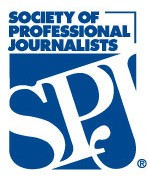 As such, it has practitioners — myself included — who consider themselves journalists (among other things). So the status of arts criticism in the world of newspapers and magazines, while a relatively small slice of the journalism pie, both merits and receives occasional attention from analysts of journalism as a whole.
As such, it has practitioners — myself included — who consider themselves journalists (among other things). So the status of arts criticism in the world of newspapers and magazines, while a relatively small slice of the journalism pie, both merits and receives occasional attention from analysts of journalism as a whole.
Case in point: “Exit the Arts Critics?” by Sam Stall, published in the Summer 2023 issue of Quill, the quarterly magazine of the Society for Professional Journalists (SPJ), of which I’m a member. You can access it here. Stall concentrates on theater criticism, but what he presents on that front applies to journalistic coverage of all the arts. The gist: Things look bad for “arts critics.” Really bad. And getting worse. With no relief in sight:
Although no one has yet chronicled the collapse of traditional cultural coverage in forensic detail, its decline is pretty obvious, even if mostly anecdotal. …
“The number of arts critics of color or critics who came out of community-based cultural groups was exceedingly few,” [Holly] Sidford said, “even when there were arts desks at most major papers. So there was always a bias to that perspective, in addition to limited coverage.” [Sidford co-directs Helicon Collaborative, a consulting company that works with communities, philanthropies, and arts and cultural organizations.]
Yet old-school media’s cutback in arts criticism and reporting still affects the entire sector, from touring Broadway shows to neighborhood cultural collectives.
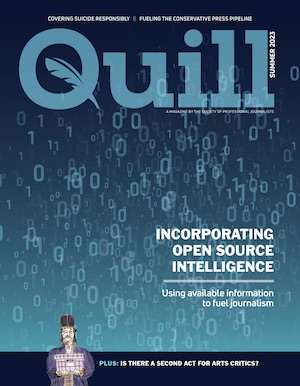
Quill, Summer 2023, cover
“Journalism wasn’t ever covering the whole field, but it’s covering even less now,” Sidford said. “So the average person sees less or learns less about all the different ways that artistic practice is going on.” …
However, there are still plenty of arts sites. They don’t pay a full-time salary, but at least they’re keeping the light of cultural coverage from guttering out entirely, and training a new generation of writers in the process.
While the decline of professional arts coverage and full-time newspaper arts journalists proceeds apace, lots of other people, for better or worse, are offering up their opinions and short-form criticism via everything from Facebook to TikTok. …
“Now everyone’s a critic,” [Sidford] said. “They’re not doing long-form criticism, but there are other forms of engagement and commentary.” … [S]ometimes those short-form, cell-phone-optimized ‘reports’ get more clicks than the site’s traditional, written pieces.
“That’s either depressing or interesting,” she said. “I try to look at it this way: The old way is not coming back, so what is the new path forward? I don’t know if anyone has figured that out yet.”
As I’ve said since, well, forever. And Stall foresees the same grim future for arts criticism as I do: produced by “freelancers or retired people who still want to contribute” (like me); self-funded (like this blog) or minimally subsidized by some grants organization; self-published (like this blog) or presented at the subsidized website of a non-profit arts organization. In short, exceedingly narrowcast, and isolated from other subjects of cultural commentary — the very antithesis of newspaper-based cultural journalism.
And the alternative? Meta (formerly Facebook), X (formerly Twitter), Instagram, TikTok, and whatever trendy social-media platforms will replace these before quickly obsolescing in turn.
This does not bode well.
Of course, there’s no reason for photographers to concern themselves with this. Nor photo-gallery owners, nor photo curators at museums, nor photo-book publishers, nor the heads of photo-specific nonprofit organizations. It will have no effect on their day-to-day activities. It will only matter if and when they mount a photo show or publish a photo book or hold a photo-related public event, and discover that there’s no one available to write about it knowledgeably, and no place for anyone to publish such writing in any case.
But hey! TikTok!
•
Is Photography…Ending?
For a comparable assessment of photography itself from the standpoint of a photographer roughly my age, see Mike Johnston’s August 28 post, “Is Photography…Ending?,” at The Online Photographer, his long-running blog.
![]() Spoiler alert: Although Johnston promises an upbeat take on the issues in the near future, his view on the prospects for skilled and knowledgeable photographers parallels my assessment of what skilled and knowledgeable arts writers face. Can you say “bleak,” boys and girls?
Spoiler alert: Although Johnston promises an upbeat take on the issues in the near future, his view on the prospects for skilled and knowledgeable photographers parallels my assessment of what skilled and knowledgeable arts writers face. Can you say “bleak,” boys and girls?
•
Tools of the Trade
Having written at some length about the relationship of the typewriter and computer to the craft of writing, I recommend Josh Giesbrecht’s brief history of and meditation on the ballpoint pen and its impact on handwriting: “How the Ballpoint Pen Killed Cursive,” The Atlantic, August 28, 2015. (It’s behind a paywall at the magazine’s website, but you can read it here.)
 You can follow that up, as The Atlantic did, with “How Handwriting Lost Its Personality,” by Rachel Gutman-Wei, published there on July 11, 2023. (This too lies behind a paywall at the magazine’s website, but you can read it here.)
You can follow that up, as The Atlantic did, with “How Handwriting Lost Its Personality,” by Rachel Gutman-Wei, published there on July 11, 2023. (This too lies behind a paywall at the magazine’s website, but you can read it here.)
Both articles (especially taken in tandem) usefully remind us that no tool or technology — and certainly no medium of communication — can ever claim neutrality. Each and every tool carries agendas both overt and hidden; each and every medium has its biases. We ignore or deny this basic truth at our peril.
•
Good Old Golden Rule Days
With the fall semester now underway, here’s a tidbit re my involvement in photo education that got lost in the shuffle:
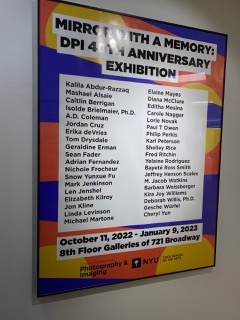
NYU/TSOA Dept. of Photography, 40th Anniversary show, 2022 (a)
The Department of Photography and Imaging at New York University’s Tisch School of the Arts, in which I taught between 1977 and 1993 (when it was called the Dept. of Photography), held its 40th Anniversary Faculty Show from October 11, 2022 through January 9, 2023. The anniversary exhibition, curated by Editha Mesina, celebrated the department’s achieving the full status of an autonomous, degree-granting undergraduate program in 1982. (Prior to that — at the time I started teaching there — it functioned as a component of the TSOA undergraduate Film & Television program.)
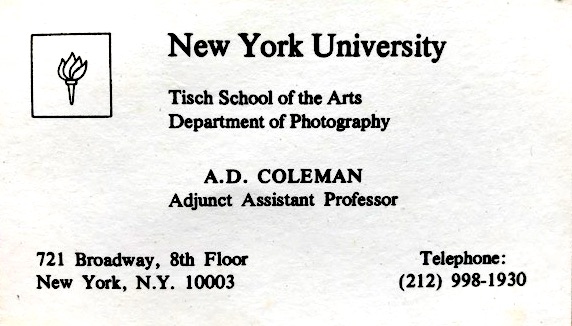 Though I declined the eventual offer of a full-time, tenure-track position, I served as the first faculty member of what gradually evolved into a substantial history, criticism & theory component of the program. After watching the university make my colleagues jump through hoops en route to tenure — including seemingly endless service on academic committees — I decided I could serve my students better by remaining an adjunct professor and keeping my non-teaching time free, thereby bringing my ongoing professional activities and experience into my classroom.
Though I declined the eventual offer of a full-time, tenure-track position, I served as the first faculty member of what gradually evolved into a substantial history, criticism & theory component of the program. After watching the university make my colleagues jump through hoops en route to tenure — including seemingly endless service on academic committees — I decided I could serve my students better by remaining an adjunct professor and keeping my non-teaching time free, thereby bringing my ongoing professional activities and experience into my classroom.
Invited late last summer to contribute to this exhibition something representing my recent/current writing activity, I decided to provide the cover and opening page of my 2020 book poetic license/poetic justice. This prose poem relates only tangentially to my work as a photo critic and historian; at the same time, it represents an aspect of my writing that my students and colleagues didn’t get to see. (See offer below.)
Busy settling in to our new home, I opted not to travel down to Manhattan for the occasion. Michael Martone, whose retrospective I curated for the department’s gallery during my time there, and who also taught briefly there as a result, attended the opening and sent these pix.
•
This post sponsored by a donation from Carlyle T.
•

Special offer: If you want me to either continue pursuing a particular subject or give you a break and (for one post) write on a topic — my choice — other than the current main story, make a donation of $50 via the PayPal widget below, indicating your preference in a note accompanying your donation. I’ll credit you as that new post’s sponsor, and link to a website of your choosing.
And, as a bonus, I’ll send you a signed copy of my new book, poetic license / poetic justice — published under my full name, Allan Douglass Coleman, which I use for my creative writing.


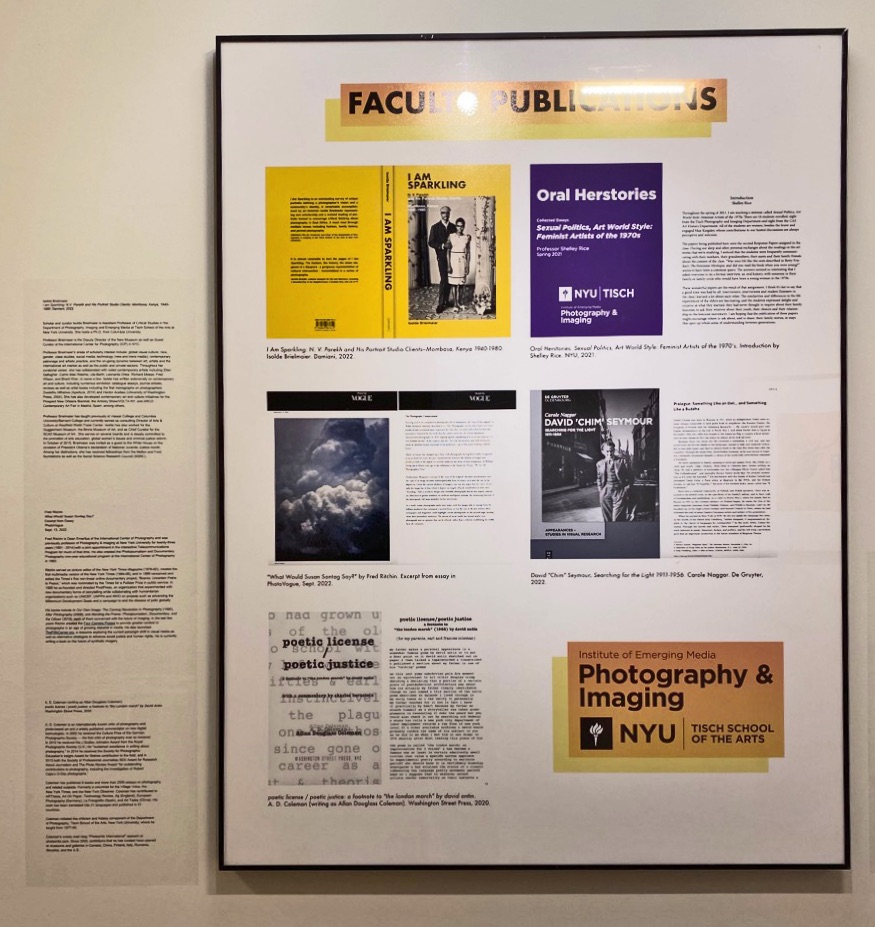




Allan ,
As you remember I started photographing and printing as a kid in 1953
I just found from storage ,film hangers and an old photo darkroom safelight
Truly speaking looking at my former darkroom mechanical tools made me feel born of another era almost nightmarish, today.
I imagine soon with t A.I. chat application protocol that writings by a human might become as old as my wet darkroom tools.
I produced my first published writings on manual typewriters … my first published professional writings on electric typewriters … feels positively Jurassic.
The first full-time photography gallery opened in Philadelphia in November 1974 and there were an increasing number of photography shows around the area but no coverage. In 1975 I started writing reviews and taking them to the newspapers. The Philadelphia Inquirer said, “No one’s going to buy a newspaper because there’s a review of a photography show.” The Evening Bulletin (now long gone) said, “This is really interesting but we have no more room on our arts page.” That was one page on the back of a section covering all the arts – visual and performing – once a week. Thus with the encouragement of friends I started The Photo Review.
By the mid 1980s through the early 2000s arts coverage in the papers expanded broadly, but with the retrenchment in local media, we are now back to the bad old days of the bare minimum of coverage. There is much work to be done and there are no easy solutions.